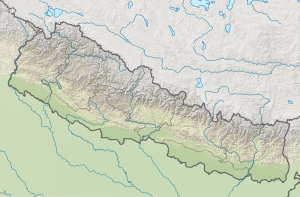|
Ghyanglekh Rural Municipality
Ghyanglekh is a Rural municipality located within the Sindhuli District of the Bagmati Province of Nepal. The municipality spans 166.77 square kilometres (64.39 sq mi) of area, with a total population of 13,661 according to a 2011 Nepal census.[1][2] On March 10, 2017, the Government of Nepal restructured the local level bodies into 753 new local level structures.[3][4] The previous Amale, Bastipur, Tamajor, Netrakali and Shanteshwari VDCs were merged to form Ghyanglekh Rural Municipality. Ghyanglekh is divided into 5 wards, with Bastipur declared the administrative center of the rural municipality. DemographicsAt the time of the 2011 Nepal census, Ghyanglekh Rural Municipality had a population of 13,761. Of these, 73.9% spoke Tamang, 9.9% Nepali, 6.8% Magar, 4.2% Newar, 2.4% Thangmi, 2.3% Sunwar, 0.3% Urdu, 0.1% Maithili and 0.1% other languages as their first language.[5] In terms of ethnicity/caste, 73.9% were Tamang, 7.1% Magar, 5.8% Newar, 3.3% Kami, 3.0% Chhetri, 2.4% Sunuwar, 2.4% Thami, 0.6% Hill Brahmin, 0.6% Damai/Dholi, 0.3% Musalman, 0.1% other Dalit, 0.1% Gharti/Bhujel, 0.1% Sarki and 0.2% others.[6] In terms of religion, 77.5% were Buddhist, 20.3% Hindu, 1.1% Christian, 0.9% Prakriti and 0.3% Muslim.[7] In terms of literacy, 49.1% could read and write, 5.5% could only read and 45.4% could neither read nor write.[8] References
External links
|
||||||||||||||||||||||||||||||||||||||||||||


